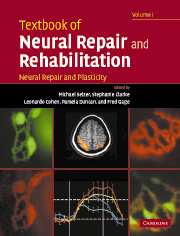Book contents
- Frontmatter
- Contents
- Contents (contents of Volume II)
- Preface
- Contributors (contributors of Volume I)
- Contributors (contributors of Volume II)
- Neural repair and rehabilitation: an introduction
- Section A Neural plasticity
- Section A1 Cellular and molecular mechanisms of neural plasticity
- Section A2 Functional plasticity in CNS system
- Section A3 Plasticity after injury to the CNS
- Section B1 Neural repair
- Section B2 Determinants of regeneration in the injured nervous system
- Section B3 Promotion of regeneration in the injured nervous system
- Section B4 Translational research: application to human neural injury
- 31 Alzheimer's disease, model systems and experimental therapeutics
- 32 Biomimetic design of neural prostheses
- 33 Brain–computer interfaces for communication and control
- 34 Status of neural repair clinical trials in brain diseases
- Index
32 - Biomimetic design of neural prostheses
from Section B4 - Translational research: application to human neural injury
Published online by Cambridge University Press: 05 March 2012
- Frontmatter
- Contents
- Contents (contents of Volume II)
- Preface
- Contributors (contributors of Volume I)
- Contributors (contributors of Volume II)
- Neural repair and rehabilitation: an introduction
- Section A Neural plasticity
- Section A1 Cellular and molecular mechanisms of neural plasticity
- Section A2 Functional plasticity in CNS system
- Section A3 Plasticity after injury to the CNS
- Section B1 Neural repair
- Section B2 Determinants of regeneration in the injured nervous system
- Section B3 Promotion of regeneration in the injured nervous system
- Section B4 Translational research: application to human neural injury
- 31 Alzheimer's disease, model systems and experimental therapeutics
- 32 Biomimetic design of neural prostheses
- 33 Brain–computer interfaces for communication and control
- 34 Status of neural repair clinical trials in brain diseases
- Index
Summary
Overview of human-machine interfaces for rehabilitation
As engineered devices and systems become more sophisticated and “intelligent” in their functionality, it is natural to apply them to the treatment of disabilities that arise through failure of their biological counterparts. It seems likely that one of the earliest tools fashioned by Homo sapiens would have been a walking stick or cane to compensate for an injured foot. The mechanical and materials science of the 18th and 19th centuries led to wheelchairs for invalids, cableoperated hooks for amputees and spectacles for myopes. These are all examples of interfaces that augment the otherwise reduced performance of a natural function.
The 20th century saw the rise of electronics, which can transduce energy between different forms, creating motion, light and sound where there was none. This led to attempts, mostly with limited success, to substitute one biological function for another (Marks, 1983; Kaczmarek et al., 1991), such as the Optacon tactile display of visual information (Hislop et al., 1983) and similar devices to represent sound (Reed et al., 1985; Tan et al., 1989; Waldstein and Boothroyd, 1995; Galvin et al., 1999), keyboard operated speech synthesizers (Carlson et al., 1981; Carlson, 1995; Flanagan, 1995; Liberman, 1995), voice-activated robots (Hammel et al., 1992; Van der Loos, 1995; Katevas et al., 1997; Burgar et al., 2000; Taylor et al., 2002) etc. Electronic communication systems use conversions from acoustic and light energy to electrical energy and back again.
Keywords
- Type
- Chapter
- Information
- Textbook of Neural Repair and Rehabilitation , pp. 587 - 601Publisher: Cambridge University PressPrint publication year: 2006
- 1
- Cited by

